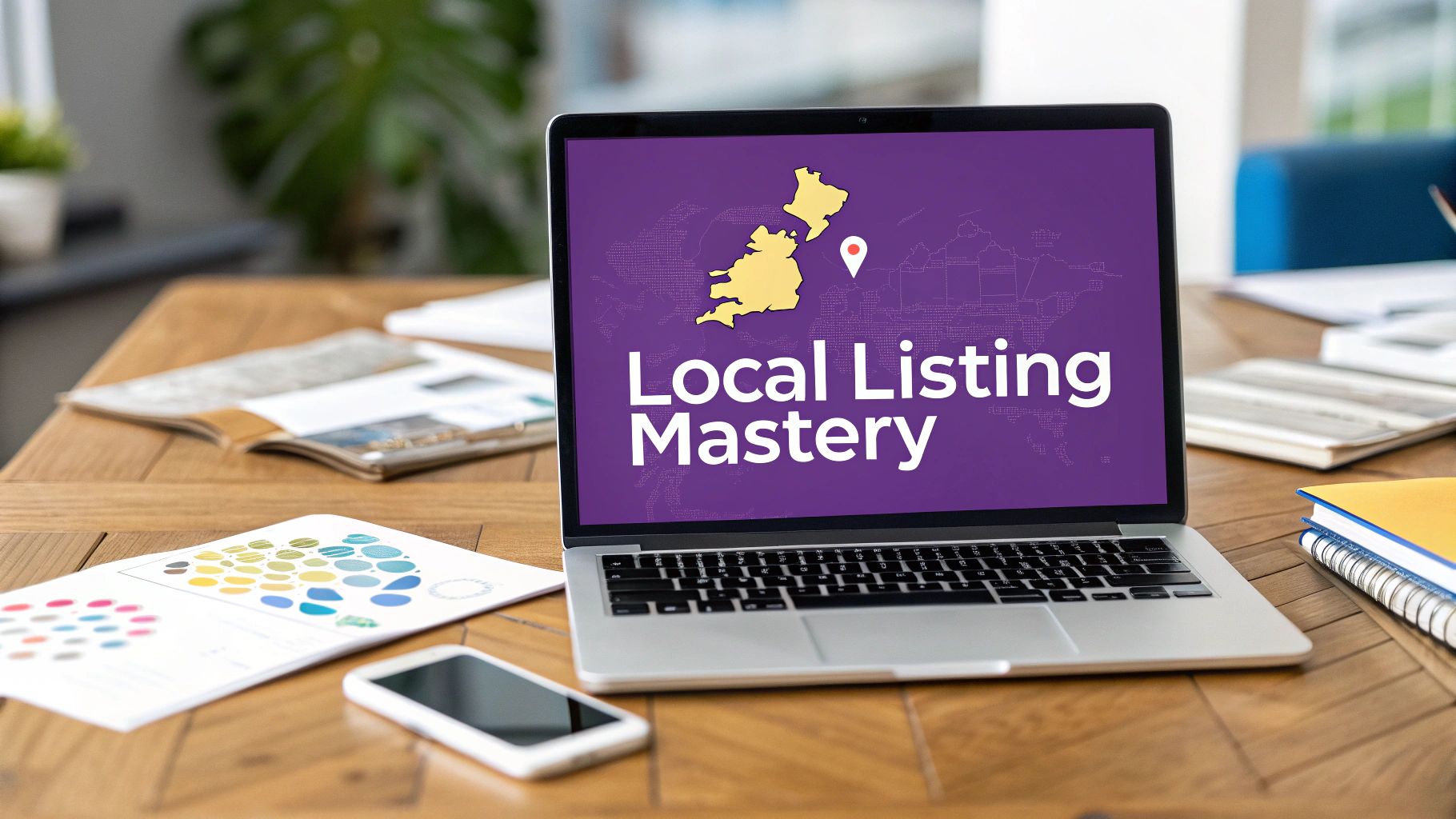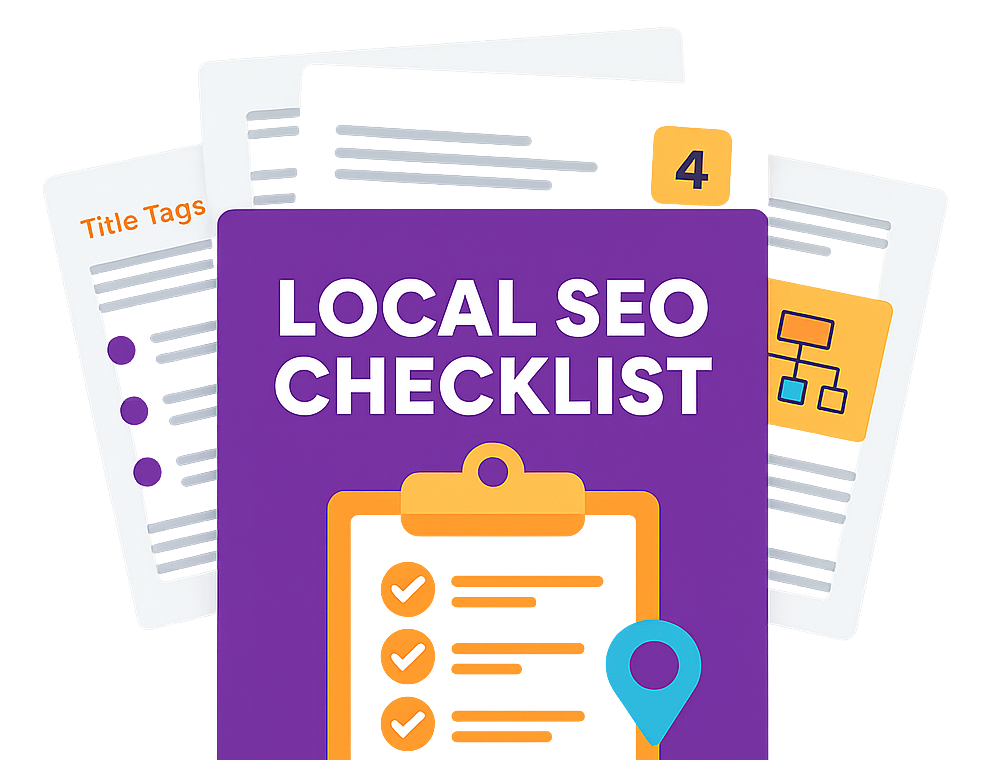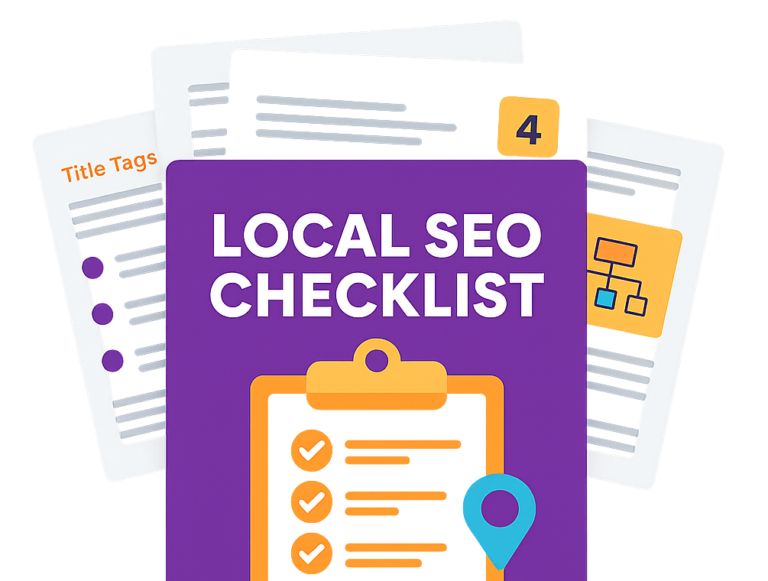Submitting your business to local directories is the simple act of getting your core details—your Name, Address, and Phone number (NAP)—listed across various online platforms. This is a foundational tactic in local SEO. It’s how search engines like Google confirm that your business actually exists where you say it does, which is absolutely critical for showing up in local search results and the Google Map Pack.
Why Local Directories Still Matter for UK Businesses

It’s a fair question: are local directories an outdated SEO trick? With so much talk about social media and complex ad campaigns, you might wonder if these simple listings still have a place. The answer is a definite yes, especially if you're a UK business trying to pull in customers from your local area.
Think of each directory listing as a small vote of confidence for your business. When Google's crawlers find your identical Name, Address, and Phone number (NAP) details across multiple trusted UK sites—like Yell, Thomson Local, or even niche industry portals—it backs up your legitimacy. This consistency sends a powerful signal that your business is real, active, and correctly located.
Building Trust with Search Engines
Let's be clear: this isn't really about getting a flood of direct traffic from the directories themselves. It’s about building a solid foundation of trust with search engines. Every single consistent NAP citation acts as another verification point, beefing up your overall local search authority. This has a direct impact on your chances of appearing in the highly-sought-after Google Map Pack—that box of three local businesses you see at the top of the search results.
For example, a plumber in Bristol with consistent listings across twenty reliable directories will look far more trustworthy to Google than a competitor who only has a few, inconsistent entries. This digital validation is what gets you noticed.
A strong, consistent presence across UK local directories isn't just about backlinks; it's about proving your business's physical reality in the digital world. This verification is fundamental to achieving high visibility in local search results.
The Enduring Value of Online Listings
The move from print to digital has only cemented the role of online directories. The old physical Yellow Pages started their digital shift back in the late 1990s, and today, their online descendants are an essential tool in any digital marketing kit. UK market data continues to show their value, with dozens of top-tier directories actively helping businesses get found and drive referral traffic.
To really get to grips with how valuable these platforms are, it's worth digging into why local business listings are essential. At the end of the day, consistent local directory submissions aren't just a tedious box-ticking exercise; they are a strategic investment in your business’s local visibility and credibility.
Finding the Right UK Directories for Your Business
When it comes to local directory submissions, the goal isn't to be everywhere; it's to be where it matters. A scattergun approach is a fast track to wasting time and, worse, getting your brand associated with low-quality, spammy websites. The real key is to get strategic and prioritise platforms that actually offer value.
This means looking past generic national lists and drilling down to the directories your customers are genuinely using. The right platforms for a plumber in Manchester will look completely different to those for a software firm in Bristol. Your job is to build a curated list based on authority, industry relevance, and real user engagement.
Differentiating Directory Types
Not all directories are created equal, and they don't all serve the same purpose. Understanding the differences is the first step in building a submission strategy that works.
- National Giants: These are the big players everyone's heard of, like Yell, Thomson Local, and Scoot. Getting listed here is a foundational step. They have high domain authority and are trusted signals for search engines.
- Specialised Trade Directories: Think of niche platforms dedicated to a specific industry, like Checkatrade for tradespeople or TripAdvisor for hospitality. They connect you directly with a highly relevant audience actively looking for what you do.
- Hyper-Local Community Sites: These are smaller directories focused on a specific town, city, or even a single neighbourhood. While they might not have the authority of the giants, they're invaluable for capturing truly local customers and showing you're part of the community.
By 2025, the best UK-based online directories have moved far beyond simple contact lists. Industry analysis shows that modern directories with features like refined geo-filters and verified reviews see user engagement rates over 340% higher than basic listings. For your business, that means users spend more time on your profile, leading to better quality leads and stronger referral traffic.
The image below gives you a sense of the scale and impact a well-thought-out local directory strategy can have.

This data really brings it home: while many businesses have a presence, there's a huge opportunity to gain an edge by properly optimising your listings and capturing that average 20% boost in referral traffic.
How to Spot and Avoid Low-Quality Directories
Knowing which directories to avoid is just as important as finding the good ones. A low-quality directory can actively harm your SEO by creating a toxic association with spam.
Before you start submitting your business details, it’s worth taking a moment to evaluate the quality of a directory. This simple step can save you a lot of headaches down the line and ensure your efforts are focused where they'll have the most impact.
Evaluating UK Directory Quality
| Evaluation Factor | What to Look For (Good Signal) | What to Avoid (Bad Signal) |
|---|---|---|
| Website Design & UX | Clean, modern, mobile-friendly design. Easy to navigate. | Outdated, clunky interface that looks 10+ years old. |
| Listing Quality | Listings are complete, verified, and relevant to the directory's focus. | Spammy, incomplete, or irrelevant listings. Lots of broken links. |
| Ad to Content Ratio | The primary focus is on business listings, not aggressive advertising. | More ads than actual content. Pop-ups everywhere. |
| Verification Process | Requires business verification (email, phone, or postcard) to create a listing. | Anyone can create a listing instantly with no checks. |
| Community Engagement | Features genuine, recent user reviews and active social profiles. | No review system, or reviews look fake. Dead social media accounts. |
A quick check against these factors will help you quickly separate the valuable directories from the digital graveyards. Prioritising quality is non-negotiable for protecting your brand's reputation and SEO health.
A single high-authority, relevant directory listing is worth more than a hundred listings on poorly maintained, irrelevant sites. Prioritise quality over sheer quantity every time.
Watch out for these red flags:
- Outdated Design: The site looks like it hasn’t been touched in a decade.
- Irrelevant Listings: The directory is a jumble of businesses with no clear industry or location focus.
- Excessive Ads: The page is so cluttered with ads you can barely find the business listings.
- No Vetting Process: It seems anyone can get a listing without verification, which is a magnet for spam.
Putting your efforts into reputable platforms is the only way to make this strategy work. For a much deeper dive into building a powerful list, check out our ultimate guide to high-authority directory submissions. It’ll help you find directories that will actively boost your local search visibility.
Preparing Your Business Information for Submission

Before you even think about starting your local directory submissions, you need to get your house in order. Success in local SEO is built on a rock-solid foundation of consistency. Seriously, even the smallest variation in your core business details can confuse search engines, watering down the power of your listings and hurting your chances to rank.
The best way to handle this is by creating a single, authoritative 'master file' or 'submission kit'. This document becomes your single source of truth for every directory you work with, guaranteeing every submission is identical. Think of it like prepping your ingredients before you start cooking—it makes the whole process faster, smoother, and much more effective.
Perfecting Your NAP Data
The heart of your submission kit is your NAP: your business Name, Address, and Phone number. This information has to be recorded exactly as it should appear everywhere online, right down to the last detail.
Take a moment to consider these critical points:
- Business Name: Is it "Smith's Electrical Ltd" or "Smith's Electrical Limited"? Pick one and stick to it religiously.
- Address: Use the full, official address as recognised by Royal Mail. Decide if you're using "Street" or "St.", "Road" or "Rd." and use it consistently.
- Phone Number: A local landline number is always best, as it reinforces your connection to the area. Make sure the formatting (like the spacing) is always the same.
Your NAP is your digital fingerprint. Absolute consistency across every single directory, social profile, and your own website tells search engines that you are exactly who and where you say you are. This is non-negotiable for building local trust.
Assembling Your Full Submission Kit
Beyond your NAP, a strong profile needs more detail. Getting these assets ready now will save you a massive amount of time later. Your master file, which can be a simple spreadsheet, should also include the following.
1. Business Description
Craft a compelling, keyword-rich summary of your business. Write a primary version of around 250 words that tells potential customers who you are, what you do, and why they should choose you. It's also smart to prepare a shorter, punchier version of about 50 words for directories with tight character limits.
2. Business Categories
Most directories will ask you to select one or more categories that best describe what you do. Do a bit of research beforehand on major directories like Yell or Google Business Profile to find the most relevant and specific categories. List your top three to five choices in your master file so you aren't guessing during the submission process.
3. Digital Assets
Gather all your high-quality digital files into one easy-to-access folder. This should include:
- Your company logo (in various sizes and formats, like PNG and JPG)
- A selection of high-resolution photos of your premises, your team, and your work in action
- Your full website URL (make sure it's the complete HTTPS version)
- Links to all your social media profiles (LinkedIn, Facebook, etc.)
Having this complete submission kit prepared is a game-changer. For a broader view of how this fits into your overall strategy, our comprehensive local SEO checklist gives you a clear roadmap to success. This kind of methodical organisation is the secret to executing efficient and impactful local directory submissions.
Getting Your Business Listed: The Submission Process
Right, you've got all your business information organised and double-checked. Now comes the important part: actually getting it out there. How you tackle local directory submissions really boils down to three things: your budget, how much time you have, and how hands-on you want to be.
There are three main paths you can take, and each one has its pros and cons. Let's walk through them so you can figure out which approach makes the most sense for your business.
The Manual Approach: Rolling Up Your Sleeves
Manual submission is exactly what it sounds like—you visit each directory one by one, then create or claim your business listing yourself. This method gives you the ultimate level of control, and aside from your time, it’s completely free. You can personally make sure every single detail is spot-on, from your NAP to the business description and photos.
Sure, it’s the most time-consuming option, but it's also the most thorough. When you manually go through each platform's interface, you can spot and use unique features that an automated tool might just skim over.
Here are a few tips to make the process a bit less painful:
- Tackle the Big Players First: Start with your Google Business Profile. It’s a non-negotiable. Then, move on to major UK directories like Yell, Thomson Local, and Scoot.
- Lean on Your Master File: Keep that spreadsheet you prepared open and ready. Copy and paste everything directly from it to avoid typos and keep things perfectly consistent.
- Keep Records: Every time you create a listing, pop the URL, your username, and password into your spreadsheet. Trust me, you’ll thank yourself later when you need to make updates.
This methodical approach guarantees maximum accuracy and lets you customise each profile properly. It's the best choice if you want complete command over how your business looks online.
Using an Automated Submission Service
If the idea of spending hours on data entry fills you with dread, an automated service could be your best bet. These tools, often called listing management platforms, take your business info and push it out to a network of dozens, sometimes hundreds, of directories all at once.
This route saves a massive amount of time and is brilliant for building a wide presence quickly. The trade-off? It costs money and you give up a bit of that fine-tuned control. Most of these services run on a subscription, with prices typically ranging from £30 to over £100 per month, depending on how many listings they’re managing for you.
Using an automated service is a classic time-versus-control decision. You get speed and scale, but you lose the ability to tweak every single listing to perfection like you can with the manual method.
Submitting to Data Aggregators
The third route is a bit more behind-the-scenes but incredibly powerful. Data aggregators are huge companies that collect, clean up, and distribute business data to a vast network of other online platforms—think search engines, satnav apps, and yes, other directories.
Submitting your details directly to these aggregators ensures your core NAP data is correct right at the source. It’s a really efficient way to fix inconsistencies and get accurate information spread far and wide. The catch is that this method usually just handles the basic data; it doesn't deal with the richer stuff like photos or detailed business descriptions.
For this reason, it’s best seen as a complementary strategy, not a standalone one. In fact, many automated listing services include aggregator submissions as part of their package anyway. Picking the right path all comes down to your resources and what you’re trying to achieve.
How to Measure Your Submission Success

Getting your business listed in local directories is a solid first step, but it’s definitely not the finish line. The real work starts after your local directory submissions go live. You need to know if all that effort is actually paying off.
This isn’t about guesswork. It’s about having a system to keep an eye on your listings, track the right numbers, and actively manage how people see your brand online. A data-led approach shows you exactly what’s working, proves the value of your efforts, and helps you fine-tune your strategy down the line.
Tracking Your Live Listings and Accuracy
First things first: you need to make sure your submissions actually went through successfully. It's crucial to check that your listings are live and, more importantly, that they are 100% accurate. Even a tiny mistake in your address or phone number can make a listing worthless and undo all your hard work to keep your NAP consistent.
A simple spreadsheet is your best friend here.
Keep a running list of every directory you’ve submitted to, and pop in the direct link to your live listing. Then, set a reminder to go through it—maybe once a month or every quarter—clicking each link to double-check that every detail is still correct. This manual check is a non-negotiable for keeping your business data clean across the web.
Monitoring Referral Traffic and Backlinks
One of the clearest ways to see the impact of directories is to track how many people they’re sending to your website. This is where a tool like Google Analytics is indispensable.
Inside Google Analytics, head to the 'Acquisition' report, then 'All Traffic', and finally click 'Referrals'. You’ll get a list of all the external sites that have sent visitors your way. Scan this list for the directory URLs you've been targeting.
You probably won’t see a massive flood of traffic from any single directory. But when you add up the visitors from dozens of listings, it can really start to make a difference. Better yet, this traffic is often from people who are actively looking for the services you offer.
Beyond traffic, SEO tools like Ahrefs or Semrush can show you the new backlinks you’ve picked up from these UK sites. A healthy backlink profile, packed with links from reputable directories, sends a strong signal to search engines that your website is trustworthy. Any solid local SEO strategies will include this kind of ongoing monitoring to make sure every action is boosting your overall search visibility.
Managing Your Online Reputation
Your directory listings are more than just data points; they're a direct line to your customers. Many of these sites feature customer reviews, which can make or break a potential sale. Keeping on top of your reputation is a huge part of measuring success.
A great way to do this is by setting up alerts for your business name with a tool like Google Alerts. This way, you get a notification whenever you’re mentioned online, including in new reviews. Responding quickly—to both the good and the bad—shows you’re engaged and that you care about your customers.
Ultimately, tracking these different metrics is what will help you get the most out of your efforts in the UK market. It can be tough to draw a straight line from a single directory link to a sale, but by looking at everything from listing accuracy to referral traffic, you get a much clearer picture of what's working.
Answering Your Questions About Local Directory Submissions
Even with a solid plan, it's normal to have a few lingering questions about the nitty-gritty of local directory submissions. Getting these sorted can save you from making simple mistakes and make sure your time and effort really pay off.
Below, I'll walk through some of the most common queries we hear from UK businesses. Think of it as a final checklist before you get started.
How Many Directories Should I Actually Submit To?
This is a classic case of quality over quantity. Your goal isn't to get listed on every obscure directory under the sun. It's about focusing your energy where it counts: on platforms that have real authority and relevance to your business.
A great starting point is to aim for 20-30 of the most authoritative UK-wide directories. This list must include your Google Business Profile, alongside the big names like Yell and Thomson Local.
Once that's done, find another 5-10 niche directories that are specific to your industry or local area. For example, a specialist medical practice won't benefit from the same directories as a local bakery. You can see how something as specific as SEO for surgeons in Cambridgeshire demands a highly focused directory strategy.
A curated list of 40 high-quality, relevant listings will deliver far more SEO value than hundreds of submissions to low-quality, spammy sites that could end up harming your reputation.
Free Versus Paid Directory Listings: Is It Worth Paying?
Most directories will offer both free and paid options, and it’s important to know the difference so you don't waste your budget.
Free listings almost always cover the essentials: your basic NAP data (Name, Address, Phone Number) and your main business category. For most directories, this is all you need.
Paid or 'premium' listings usually unlock extra features. This might include adding a photo gallery, writing a much longer business description, getting a more prominent link to your website, or appearing higher up in the directory's own search results.
For the vast majority of businesses, the priority should be locking in a complete and accurate free listing on every relevant platform. Only think about paying for a premium spot on one or two key directories that are famous for driving serious, high-quality traffic in your specific sector.
What To Do When Your Business Address Changes
Moving premises requires a methodical and immediate update across all your online listings. If you don't act fast, you'll create major NAP consistency issues that can confuse search engines and customers.
First things first, update your own website and the master spreadsheet where you track all your business information. Get your own house in order before you tell anyone else.
Next, your absolute top priority is to update your Google Business Profile. This is your most important local listing, hands down. After that, work through your list of directories one by one, logging in to change your details. It can be a real grind, which is where a listing management service really shows its value—it can push the update across its entire network at once, ensuring a quick and consistent changeover.
At Bare Digital, we specialise in creating targeted local SEO strategies that get results. Our expert team can manage your local directory submissions, ensuring your business information is consistent, accurate, and working hard to attract more customers. Take the first step towards better local visibility by requesting your free, no-obligation SEO proposal today. Learn more at https://www.bare-digital.com.








